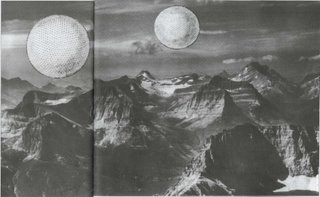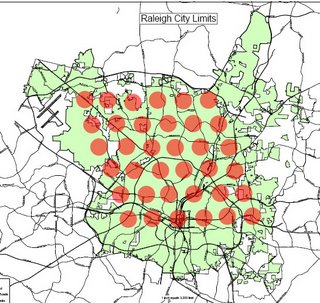Cloud Nine (original) (raw)
Among Buckminster Fuller’s more far reaching ideas was his proposal for a Cloud Nine structure. Cloud Nine was a project in which Fuller suggested that large spheres constructed using his geodesic dome structure could float and support living spaces for thousands of people. The geodesic dome is a structure which becomes much stronger as it becomes larger; Fuller along with others feels that a sphere of this construction is quite possible and has calculated that a geodesic sphere, a half mile in diameter, with all of its structure would weigh only one thousandth the amount of the weight of the air trapped inside. A sphere one mile in diameter, with interior air temperature raise o nly one degree would function as a huge hot air balloon and could support several thousand people. In Fuller’s image shown on the left, he has suggested that such spheres could possibly float between mountains and be tethered to them. While each unit could act independently, Fuller also began to speculate how they could interact with each other and the world below; he suggests the use of photovoltaically powered aircraft (solar powered), an idea taken from Dr. Paul MacReady, as the primary means of transportation between these spheres.
nly one degree would function as a huge hot air balloon and could support several thousand people. In Fuller’s image shown on the left, he has suggested that such spheres could possibly float between mountains and be tethered to them. While each unit could act independently, Fuller also began to speculate how they could interact with each other and the world below; he suggests the use of photovoltaically powered aircraft (solar powered), an idea taken from Dr. Paul MacReady, as the primary means of transportation between these spheres.
On a larger scale Fuller hoped that Cloud Nine spheres could create communities able to migrate according to changes in environment, population, culture, or any other varying conditions. Another important part of the vision is that Cloud Nine would offer a means for people to “converge and deploy around Earth without its depletion.”
Little follow up has been done on this particular vision of Fuller’s, but it is interesting to speculate on how a Cloud Nine city would function. If we assume that the average Cloud Nine structure supports 7,000 people, it would take between 35 and 36 spheres to  create a city of 250,000. A present day city of similar population is Raleigh, NC with a population of about 260,000 (Census 2000).
create a city of 250,000. A present day city of similar population is Raleigh, NC with a population of about 260,000 (Census 2000).
This first collage explores what a city of 36 Cloud Nine spheres might look like. Since each sphere is also meant to be a self supporting community it is interesting to picture such a city in landscape otherwise unused by humans. As mentioned, Fuller’s idea was that Cloud Nine would allow minimum disturbance to the natural environment below, it becomes interesting to note what a flock of these semi-permanent spheres would do to a landscape, for instance, the Cloud Nine city modeled below would create areas of constant shadow on the desert floor, a condition not natural to this location. Would the sphere cities also have other unperceived impacts on the environment surrounding the community?
the Cloud Nine city modeled below would create areas of constant shadow on the desert floor, a condition not natural to this location. Would the sphere cities also have other unperceived impacts on the environment surrounding the community?
Assuming that it would not be preferred for some spheres to occupy space below others, and that a certain spacing would be required between the spheres (for the purposes of allowing sunlight to enter each sphere properly), the map below predicts how the plan layout of a city of 250,000 inhabitants compares to the space covered by a typical city today of that size. The city of Raleigh, NC has been used in this map for means of comparison.
Finally, Buckminster Fuller only briefly mentions that the Cloud Nine spheres could support “several thousand” inhabitants. How would the space of the sphere be divided to allow for communities of this size to inhabit the spaces efficently. The following sketches are my own speculation and experimentation based on some rough statistics.
Sketch to come